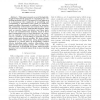Free Online Productivity Tools
i2Speak
i2Symbol
i2OCR
iTex2Img
iWeb2Print
iWeb2Shot
i2Type
iPdf2Split
iPdf2Merge
i2Bopomofo
i2Arabic
i2Style
i2Image
i2PDF
iLatex2Rtf
Sci2ools
ICRA
2008
IEEE
2008
IEEE
Anatomy-based organization of modular robots
Abstract— This paper presents a novel biologicallyinspired hierarchical approach to organizing and controlling modular robots. The purpose of our approach is to decompose the complexity of assembling and commanding a functional robot made of numerous simple modules (thousands to millions) by introducing a hierarchy of structure and control. The robots we describe incorporate anatomically-inspired parts such as muscles, bones and joints, and these parts in turn are assembled from modules. Each of those parts encapsulates one or more functions, e.g. a muscle can contract. Control of the robot can then be cast as a problem of controlling its anatomical parts rather than each discrete module. We show simulation results from experiments using gradient-based primitives to control parts of increasingly complex robots, including snake, crawler, cilia-surface, armjoint-muscle and grasping robots. We conclude that this approach is promising for future many-modules systems, but is currently imp...
ICRA 2008 | Incorporate Anatomically-inspired Parts | Modular Robots | Numerous Simple Modules | Robotics |
| Added | 30 May 2010 |
| Updated | 30 May 2010 |
| Type | Conference |
| Year | 2008 |
| Where | ICRA |
| Authors | David Johan Christensen, Jason Campbell |
Comments (0)

